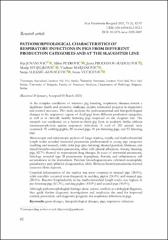Pathomorphological characteristics of respiratory infections in pigs from different production categories and at the slaughter line

View/
Date
2025Author
Jovanović, IIlija
Petrović, Miloš
Prodanov-Radulović, Jasna
Stojiljković, Marija
Marjanović, Vladimir
Aleksić–Kovačević, Sanja
Vučićević, Ivana
Metadata
Show full item recordAbstract
In the complex conditions of intensive pig breeding, respiratory diseases remain a signifi cant health and economic challenge, despite substantial progress in diagnostics and control measures. This study analyzes the pathoanatomical and histopathological changes in the respiratory organs of dead pigs from different production categories, as well as in clinically healthy fattening pigs inspected on the slaughter line. The research was conducted on a farrow-to-fi nish pig farm in southern Serbia without immunoprophylaxis against respiratory infections. A total of 182 animals were examined: 50 suckling piglets, 50 weaned pigs, 30 pre-fattening pigs, and 52 fattening pigs. Macroscopic and microscopic analysis of lungs, trachea, tonsils, and tracheobronchial lymph nodes revealed interstitial pneumonia predominated in young pigs categories (suckling and weaned), while older pigs (pre-fattening) showed purulent, fi brinous, and mixed broncho-interstitial pneumonia, often with pleural adhesions. Among fattening pigs, 82.7per cent showed no macroscopic lung changes. In cases of interstitial pneumonia, histology revealed type II pneumocyte hyperplasia, fi brosis, and infl ammatory cell accumulation in the interstitium. Purulent bronchopneumonia exhibited neutrophilic granulocytes and epithelial desquamation, while fi brinous bronchopneumonia showed extensive fi brin deposits. Catarrhal infl ammation of the trachea was most common in weaned pigs (38.0per cent), while tonsillitis occurred most frequently in suckling piglets (24.0per cent) and weaned pigs (28.0per cent). Reactive lymphadenitis in the tracheobronchial lymph nodes was highest in pre-fattening pigs (63.3per cent), suckling piglets (44.0per cent) and weaned pigs (40.0per cent). Although pathomorphological fi ndings alone cannot confi rm an etiological diagnosis, they guide further diagnostic investigations and emphasize the need for improved control, prevention, and diagnostic programs for respiratory infections in pigs.
